Accounting Report: Users of Financial Statements and Their Purposes
VerifiedAdded on 2021/02/20
|12
|3011
|57
Report
AI Summary
This report provides a comprehensive comparison of financial and management accounting, detailing their key differences in terms of definition, purpose, objective, users, and reporting focus. The report also explores the various users of financial statements, including internal users such as management and employees, and external users such as investors, trade creditors, lenders, and the government. It explains the specific purposes for which each user group utilizes financial information, highlighting how they assess a company's financial performance and make informed decisions. The report covers aspects like the differences in mandatory compliance, format of preparation, scope, and the nature of information considered in both types of accounting. Furthermore, it explains how financial accounting focuses on evaluating the overall financial position and profitability, while management accounting is more concerned with operational reports and internal decision-making within the company. The report is available on Desklib, a platform offering resources for students.

Accounting
Paraphrase This Document
Need a fresh take? Get an instant paraphrase of this document with our AI Paraphraser
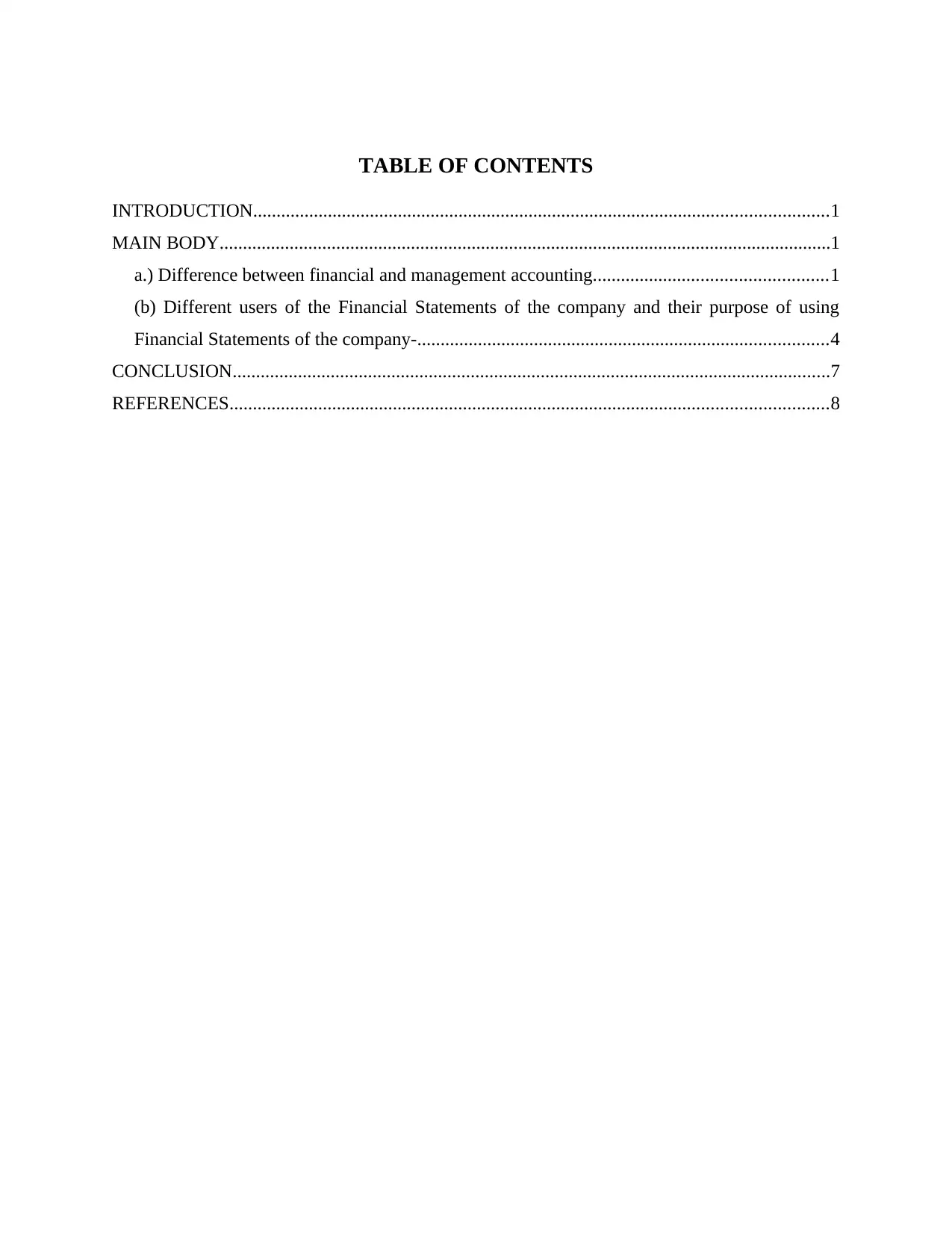
TABLE OF CONTENTS
INTRODUCTION...........................................................................................................................1
MAIN BODY...................................................................................................................................1
a.) Difference between financial and management accounting..................................................1
(b) Different users of the Financial Statements of the company and their purpose of using
Financial Statements of the company-........................................................................................4
CONCLUSION................................................................................................................................7
REFERENCES................................................................................................................................8
INTRODUCTION...........................................................................................................................1
MAIN BODY...................................................................................................................................1
a.) Difference between financial and management accounting..................................................1
(b) Different users of the Financial Statements of the company and their purpose of using
Financial Statements of the company-........................................................................................4
CONCLUSION................................................................................................................................7
REFERENCES................................................................................................................................8

INTRODUCTION
Accounting is the process where all the financial transactions of the company are
analysed, recorded, summarised and on the basis of the reports various interpretation are made
for the company (Accounting, 2019). Accounting is the stream under which various different
reports related to cost accounting, management accounting, Financial accounting etc. are
prepared. These reports are than used by the various users of the company who are interested in
knowing the company's financial position in order to evaluate the performance of the company.
Accounting is the vast concept which includes double entry systems and uses Generally
Accepted Accounting Principles (GAAP) to prepare financial statements for the various
companies. Accounting prepares the financial statements for the company which consists of
Trading and Profit & Loss account, Balance Sheet and Cash Flow Statement (Hoyle, 2015). The
report consists of difference between financial accounting and management accounting. It also
consists of the various users of the financial statements and purpose that why users use this
information.
MAIN BODY
a.) Difference between financial and management accounting.
PARTICULARS FINANCIAL
ACCOUNTING
MANAGEMENT
ACCOUNTING
1
Accounting is the process where all the financial transactions of the company are
analysed, recorded, summarised and on the basis of the reports various interpretation are made
for the company (Accounting, 2019). Accounting is the stream under which various different
reports related to cost accounting, management accounting, Financial accounting etc. are
prepared. These reports are than used by the various users of the company who are interested in
knowing the company's financial position in order to evaluate the performance of the company.
Accounting is the vast concept which includes double entry systems and uses Generally
Accepted Accounting Principles (GAAP) to prepare financial statements for the various
companies. Accounting prepares the financial statements for the company which consists of
Trading and Profit & Loss account, Balance Sheet and Cash Flow Statement (Hoyle, 2015). The
report consists of difference between financial accounting and management accounting. It also
consists of the various users of the financial statements and purpose that why users use this
information.
MAIN BODY
a.) Difference between financial and management accounting.
PARTICULARS FINANCIAL
ACCOUNTING
MANAGEMENT
ACCOUNTING
1
⊘ This is a preview!⊘
Do you want full access?
Subscribe today to unlock all pages.

Trusted by 1+ million students worldwide
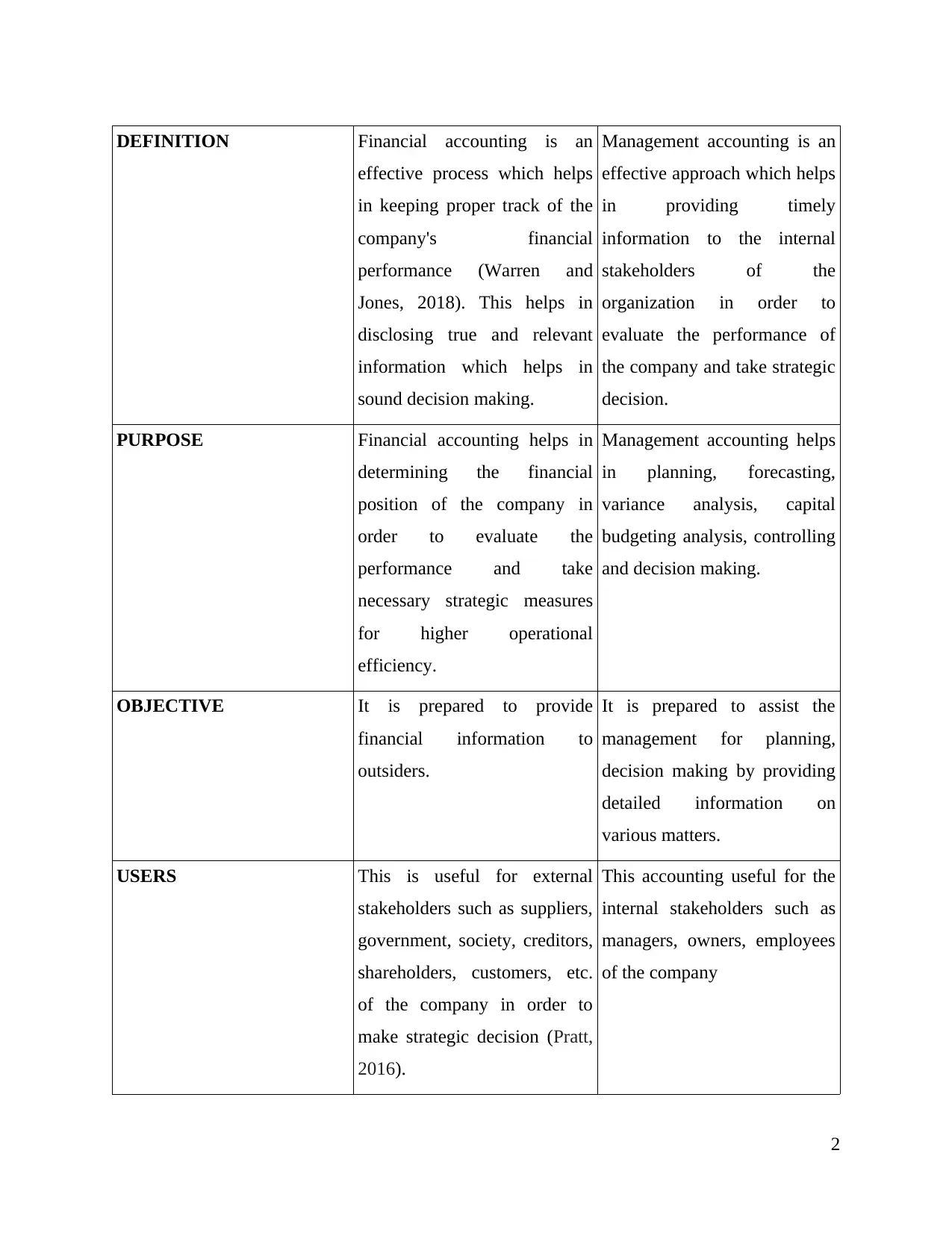
DEFINITION Financial accounting is an
effective process which helps
in keeping proper track of the
company's financial
performance (Warren and
Jones, 2018). This helps in
disclosing true and relevant
information which helps in
sound decision making.
Management accounting is an
effective approach which helps
in providing timely
information to the internal
stakeholders of the
organization in order to
evaluate the performance of
the company and take strategic
decision.
PURPOSE Financial accounting helps in
determining the financial
position of the company in
order to evaluate the
performance and take
necessary strategic measures
for higher operational
efficiency.
Management accounting helps
in planning, forecasting,
variance analysis, capital
budgeting analysis, controlling
and decision making.
OBJECTIVE It is prepared to provide
financial information to
outsiders.
It is prepared to assist the
management for planning,
decision making by providing
detailed information on
various matters.
USERS This is useful for external
stakeholders such as suppliers,
government, society, creditors,
shareholders, customers, etc.
of the company in order to
make strategic decision (Pratt,
2016).
This accounting useful for the
internal stakeholders such as
managers, owners, employees
of the company
2
effective process which helps
in keeping proper track of the
company's financial
performance (Warren and
Jones, 2018). This helps in
disclosing true and relevant
information which helps in
sound decision making.
Management accounting is an
effective approach which helps
in providing timely
information to the internal
stakeholders of the
organization in order to
evaluate the performance of
the company and take strategic
decision.
PURPOSE Financial accounting helps in
determining the financial
position of the company in
order to evaluate the
performance and take
necessary strategic measures
for higher operational
efficiency.
Management accounting helps
in planning, forecasting,
variance analysis, capital
budgeting analysis, controlling
and decision making.
OBJECTIVE It is prepared to provide
financial information to
outsiders.
It is prepared to assist the
management for planning,
decision making by providing
detailed information on
various matters.
USERS This is useful for external
stakeholders such as suppliers,
government, society, creditors,
shareholders, customers, etc.
of the company in order to
make strategic decision (Pratt,
2016).
This accounting useful for the
internal stakeholders such as
managers, owners, employees
of the company
2
Paraphrase This Document
Need a fresh take? Get an instant paraphrase of this document with our AI Paraphraser

IS IT COMPULSORY ? Yes, it is mandatory to prepare
by all the companies.
No, it is not mandatory to
prepare and it is prepared on
the voluntary basis.
FORMAT OF
PREPARATION
There is specified format for
financial accounting.
There is no specified format
for the financial accounting.
LAW/ RULES Financial accounting has to be
conducted with compliance
with proper standards,
guidelines and laws such as
GAAP, IFRS and prescribed
format.
It is not necessary or
mandatory to comply with
necessary law and standards
while carrying out
management accounting
(Hendersonand et.al., 2015).
SCOPE The scope of the financial
accounting is very wide as it
evaluates the overall financial
position of the company.
The scope of the management
accounting is narrow as it
evaluates particular segment,
department, product, cost unit,
etc.
NATURE OF
INFORMATION
Financial accounting takes into
consideration only financial
and monetary transaction.
Management accounting takes
into consideration both
financial as well as non-
financial information
(Weetman, 2019).
TIME PERIOD Financial accounting mainly
consider past historical records
to compare and evaluate the
financial results and
performance over the period.
Management accounting takes
into consideration past
historical data and forward
looking in order to evaluate the
past performance and forecast
the future needs of the
company.
PREPARATION OF Financial statements consists Management accounting report
3
by all the companies.
No, it is not mandatory to
prepare and it is prepared on
the voluntary basis.
FORMAT OF
PREPARATION
There is specified format for
financial accounting.
There is no specified format
for the financial accounting.
LAW/ RULES Financial accounting has to be
conducted with compliance
with proper standards,
guidelines and laws such as
GAAP, IFRS and prescribed
format.
It is not necessary or
mandatory to comply with
necessary law and standards
while carrying out
management accounting
(Hendersonand et.al., 2015).
SCOPE The scope of the financial
accounting is very wide as it
evaluates the overall financial
position of the company.
The scope of the management
accounting is narrow as it
evaluates particular segment,
department, product, cost unit,
etc.
NATURE OF
INFORMATION
Financial accounting takes into
consideration only financial
and monetary transaction.
Management accounting takes
into consideration both
financial as well as non-
financial information
(Weetman, 2019).
TIME PERIOD Financial accounting mainly
consider past historical records
to compare and evaluate the
financial results and
performance over the period.
Management accounting takes
into consideration past
historical data and forward
looking in order to evaluate the
past performance and forecast
the future needs of the
company.
PREPARATION OF Financial statements consists Management accounting report
3

REPORTS of income statement, balance
sheet, cash flow statement and
statement of change in equity
which are prepared every
financial year ending (Kaplan
and Atkinson, 2015).
mainly constitutes budget
report, performance report,
accounts receivable report,
cost report, job costing, etc.
which can be prepared for any
period i.e., weekly, monthly,
daily.
VALUATION Financial accounting is
concerned with the valuation
and revaluation of the assets
and liabilities.
Management accounting is not
concerned with the valuation
of the assets and liabilities. It
is mainly concerned with the
productivity and profitability
from the desired job or
product.
EFFICIENCY Financial accounting is
concerned with evaluation of
profitability and efficiency of
the company.
Management accounting is
mainly concerned in
determining the problems in
the process and finding
effective ways to fix them.
REPORTING FOCUS Financial accounting focuses
on preparation of financial
statements which are
distributed within and outside
of the company (Warren and
Jones, 2018).
Management accounting
mainly focuses on operational
reports which are distributed
within the company which
helps in further decision
making by the internal
management of the
organization.
PUBLISHED AND
AUDITING
These reports are to be
published and reported by
These reports are neither
published nor audited by
4
sheet, cash flow statement and
statement of change in equity
which are prepared every
financial year ending (Kaplan
and Atkinson, 2015).
mainly constitutes budget
report, performance report,
accounts receivable report,
cost report, job costing, etc.
which can be prepared for any
period i.e., weekly, monthly,
daily.
VALUATION Financial accounting is
concerned with the valuation
and revaluation of the assets
and liabilities.
Management accounting is not
concerned with the valuation
of the assets and liabilities. It
is mainly concerned with the
productivity and profitability
from the desired job or
product.
EFFICIENCY Financial accounting is
concerned with evaluation of
profitability and efficiency of
the company.
Management accounting is
mainly concerned in
determining the problems in
the process and finding
effective ways to fix them.
REPORTING FOCUS Financial accounting focuses
on preparation of financial
statements which are
distributed within and outside
of the company (Warren and
Jones, 2018).
Management accounting
mainly focuses on operational
reports which are distributed
within the company which
helps in further decision
making by the internal
management of the
organization.
PUBLISHED AND
AUDITING
These reports are to be
published and reported by
These reports are neither
published nor audited by
4
⊘ This is a preview!⊘
Do you want full access?
Subscribe today to unlock all pages.

Trusted by 1+ million students worldwide

statutory auditors. statutory auditors (Kaplan and
Atkinson, 2015).
(b) Different users of the Financial Statements of the company and their purpose of using
Financial Statements of the company-
Financial Statements are used by the person who are interested in knowing the financial
position of the company in order to know the performance of the company (Hoque, 2018). These
users are either having existing business with the company or either they want to enter into new
business with the company in near future. There are two types of users of the company i.e.
Internal users and External users. Internal users of the financial statements are within the
organisation only. Internal users of the company are those who uses company's financial
statements in order to take certain decisions for the company. For example, Management, etc.
External users of the company are those who are not involved in taking the decisions for the
company but have some financial interest in the company. External users are outside the
organisation and does not work within the organisation. For example, Government, Customers,
Trade Creditors, Investors etc. The different types of users of Financial Statements of the
company are-
Internal users of the financial statements of the company-
Management-
The main user of the financial statement of the company are Management. Management
is the internal user of the financial statements of the company. They are the one who are highly
interested in the Financial Statements of the company. They consist of Board of Directors,
managers and other officers of the business (Hawn, 2016). They are interested in the company's
financial statements because they are the one who evaluate the performance of the business and
take certain decisions related to the company. They are interested in knowing the profits of the
company and by evaluating performance of the company using ratio analysis techniques. These
techniques helps managers in knowing that whether the company will be meeting all its
obligations on time or not. These ratio helps them to know the liquidity, profitability and
5
Atkinson, 2015).
(b) Different users of the Financial Statements of the company and their purpose of using
Financial Statements of the company-
Financial Statements are used by the person who are interested in knowing the financial
position of the company in order to know the performance of the company (Hoque, 2018). These
users are either having existing business with the company or either they want to enter into new
business with the company in near future. There are two types of users of the company i.e.
Internal users and External users. Internal users of the financial statements are within the
organisation only. Internal users of the company are those who uses company's financial
statements in order to take certain decisions for the company. For example, Management, etc.
External users of the company are those who are not involved in taking the decisions for the
company but have some financial interest in the company. External users are outside the
organisation and does not work within the organisation. For example, Government, Customers,
Trade Creditors, Investors etc. The different types of users of Financial Statements of the
company are-
Internal users of the financial statements of the company-
Management-
The main user of the financial statement of the company are Management. Management
is the internal user of the financial statements of the company. They are the one who are highly
interested in the Financial Statements of the company. They consist of Board of Directors,
managers and other officers of the business (Hawn, 2016). They are interested in the company's
financial statements because they are the one who evaluate the performance of the business and
take certain decisions related to the company. They are interested in knowing the profits of the
company and by evaluating performance of the company using ratio analysis techniques. These
techniques helps managers in knowing that whether the company will be meeting all its
obligations on time or not. These ratio helps them to know the liquidity, profitability and
5
Paraphrase This Document
Need a fresh take? Get an instant paraphrase of this document with our AI Paraphraser
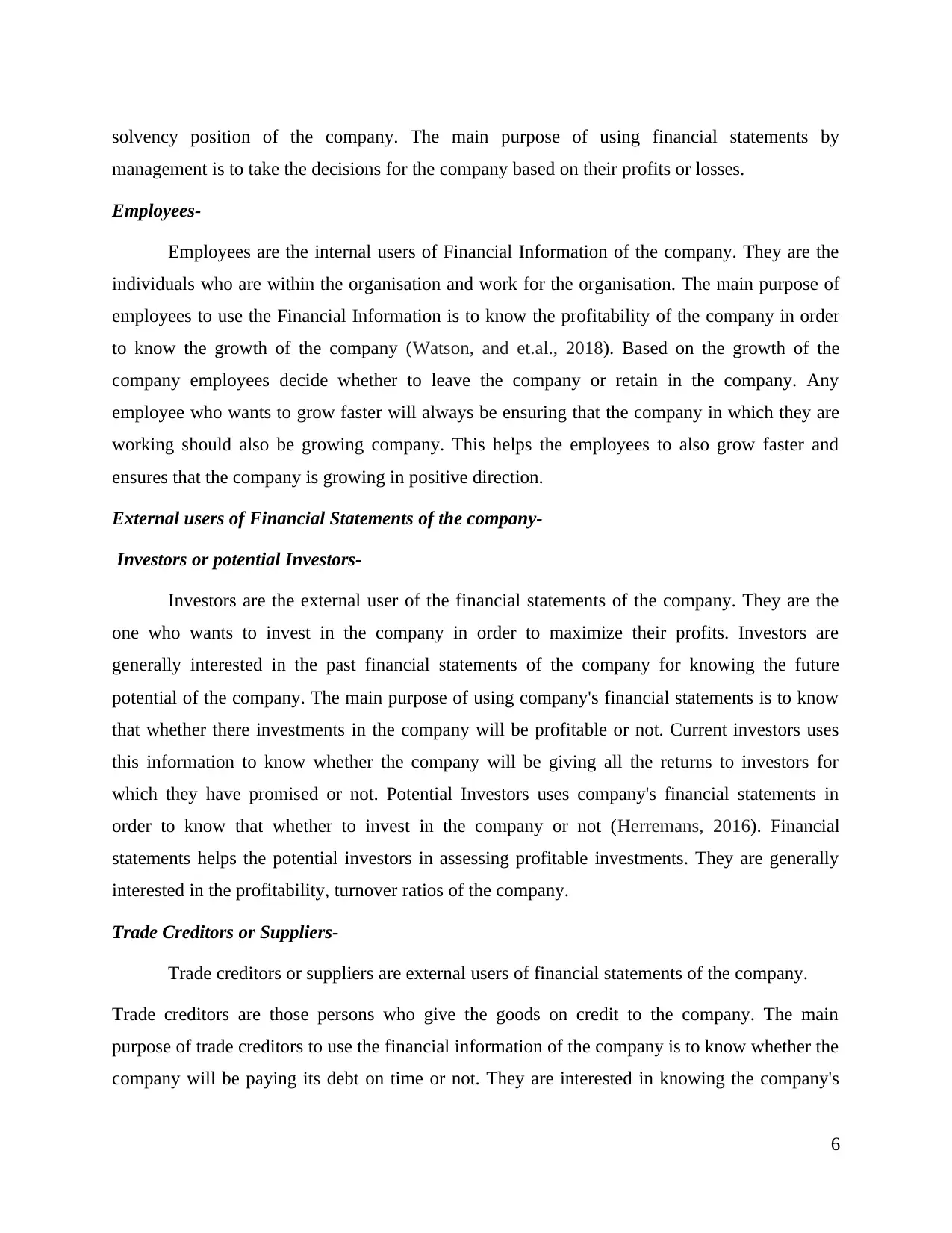
solvency position of the company. The main purpose of using financial statements by
management is to take the decisions for the company based on their profits or losses.
Employees-
Employees are the internal users of Financial Information of the company. They are the
individuals who are within the organisation and work for the organisation. The main purpose of
employees to use the Financial Information is to know the profitability of the company in order
to know the growth of the company (Watson, and et.al., 2018). Based on the growth of the
company employees decide whether to leave the company or retain in the company. Any
employee who wants to grow faster will always be ensuring that the company in which they are
working should also be growing company. This helps the employees to also grow faster and
ensures that the company is growing in positive direction.
External users of Financial Statements of the company-
Investors or potential Investors-
Investors are the external user of the financial statements of the company. They are the
one who wants to invest in the company in order to maximize their profits. Investors are
generally interested in the past financial statements of the company for knowing the future
potential of the company. The main purpose of using company's financial statements is to know
that whether there investments in the company will be profitable or not. Current investors uses
this information to know whether the company will be giving all the returns to investors for
which they have promised or not. Potential Investors uses company's financial statements in
order to know that whether to invest in the company or not (Herremans, 2016). Financial
statements helps the potential investors in assessing profitable investments. They are generally
interested in the profitability, turnover ratios of the company.
Trade Creditors or Suppliers-
Trade creditors or suppliers are external users of financial statements of the company.
Trade creditors are those persons who give the goods on credit to the company. The main
purpose of trade creditors to use the financial information of the company is to know whether the
company will be paying its debt on time or not. They are interested in knowing the company's
6
management is to take the decisions for the company based on their profits or losses.
Employees-
Employees are the internal users of Financial Information of the company. They are the
individuals who are within the organisation and work for the organisation. The main purpose of
employees to use the Financial Information is to know the profitability of the company in order
to know the growth of the company (Watson, and et.al., 2018). Based on the growth of the
company employees decide whether to leave the company or retain in the company. Any
employee who wants to grow faster will always be ensuring that the company in which they are
working should also be growing company. This helps the employees to also grow faster and
ensures that the company is growing in positive direction.
External users of Financial Statements of the company-
Investors or potential Investors-
Investors are the external user of the financial statements of the company. They are the
one who wants to invest in the company in order to maximize their profits. Investors are
generally interested in the past financial statements of the company for knowing the future
potential of the company. The main purpose of using company's financial statements is to know
that whether there investments in the company will be profitable or not. Current investors uses
this information to know whether the company will be giving all the returns to investors for
which they have promised or not. Potential Investors uses company's financial statements in
order to know that whether to invest in the company or not (Herremans, 2016). Financial
statements helps the potential investors in assessing profitable investments. They are generally
interested in the profitability, turnover ratios of the company.
Trade Creditors or Suppliers-
Trade creditors or suppliers are external users of financial statements of the company.
Trade creditors are those persons who give the goods on credit to the company. The main
purpose of trade creditors to use the financial information of the company is to know whether the
company will be paying its debt on time or not. They are interested in knowing the company's
6
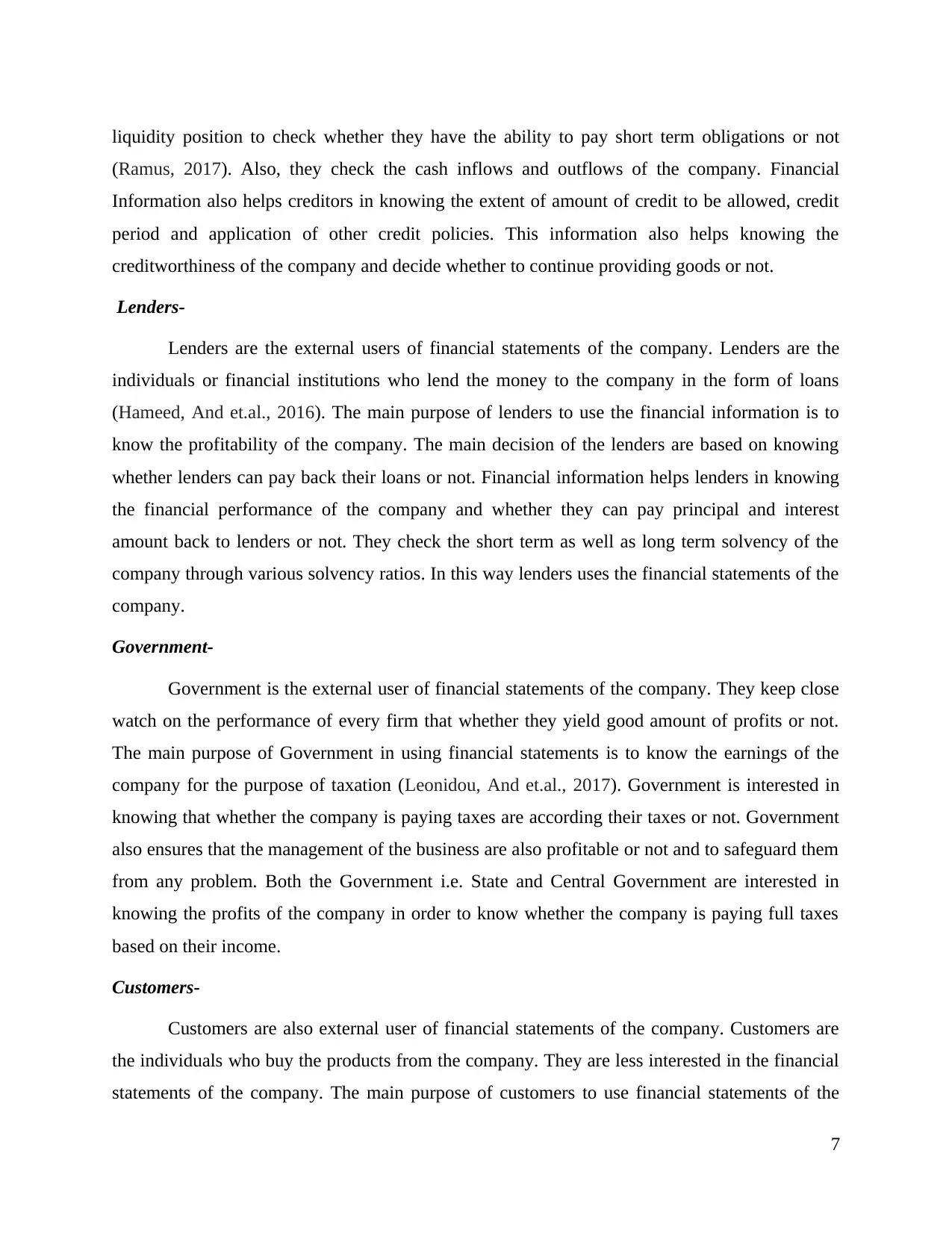
liquidity position to check whether they have the ability to pay short term obligations or not
(Ramus, 2017). Also, they check the cash inflows and outflows of the company. Financial
Information also helps creditors in knowing the extent of amount of credit to be allowed, credit
period and application of other credit policies. This information also helps knowing the
creditworthiness of the company and decide whether to continue providing goods or not.
Lenders-
Lenders are the external users of financial statements of the company. Lenders are the
individuals or financial institutions who lend the money to the company in the form of loans
(Hameed, And et.al., 2016). The main purpose of lenders to use the financial information is to
know the profitability of the company. The main decision of the lenders are based on knowing
whether lenders can pay back their loans or not. Financial information helps lenders in knowing
the financial performance of the company and whether they can pay principal and interest
amount back to lenders or not. They check the short term as well as long term solvency of the
company through various solvency ratios. In this way lenders uses the financial statements of the
company.
Government-
Government is the external user of financial statements of the company. They keep close
watch on the performance of every firm that whether they yield good amount of profits or not.
The main purpose of Government in using financial statements is to know the earnings of the
company for the purpose of taxation (Leonidou, And et.al., 2017). Government is interested in
knowing that whether the company is paying taxes are according their taxes or not. Government
also ensures that the management of the business are also profitable or not and to safeguard them
from any problem. Both the Government i.e. State and Central Government are interested in
knowing the profits of the company in order to know whether the company is paying full taxes
based on their income.
Customers-
Customers are also external user of financial statements of the company. Customers are
the individuals who buy the products from the company. They are less interested in the financial
statements of the company. The main purpose of customers to use financial statements of the
7
(Ramus, 2017). Also, they check the cash inflows and outflows of the company. Financial
Information also helps creditors in knowing the extent of amount of credit to be allowed, credit
period and application of other credit policies. This information also helps knowing the
creditworthiness of the company and decide whether to continue providing goods or not.
Lenders-
Lenders are the external users of financial statements of the company. Lenders are the
individuals or financial institutions who lend the money to the company in the form of loans
(Hameed, And et.al., 2016). The main purpose of lenders to use the financial information is to
know the profitability of the company. The main decision of the lenders are based on knowing
whether lenders can pay back their loans or not. Financial information helps lenders in knowing
the financial performance of the company and whether they can pay principal and interest
amount back to lenders or not. They check the short term as well as long term solvency of the
company through various solvency ratios. In this way lenders uses the financial statements of the
company.
Government-
Government is the external user of financial statements of the company. They keep close
watch on the performance of every firm that whether they yield good amount of profits or not.
The main purpose of Government in using financial statements is to know the earnings of the
company for the purpose of taxation (Leonidou, And et.al., 2017). Government is interested in
knowing that whether the company is paying taxes are according their taxes or not. Government
also ensures that the management of the business are also profitable or not and to safeguard them
from any problem. Both the Government i.e. State and Central Government are interested in
knowing the profits of the company in order to know whether the company is paying full taxes
based on their income.
Customers-
Customers are also external user of financial statements of the company. Customers are
the individuals who buy the products from the company. They are less interested in the financial
statements of the company. The main purpose of customers to use financial statements of the
7
⊘ This is a preview!⊘
Do you want full access?
Subscribe today to unlock all pages.

Trusted by 1+ million students worldwide
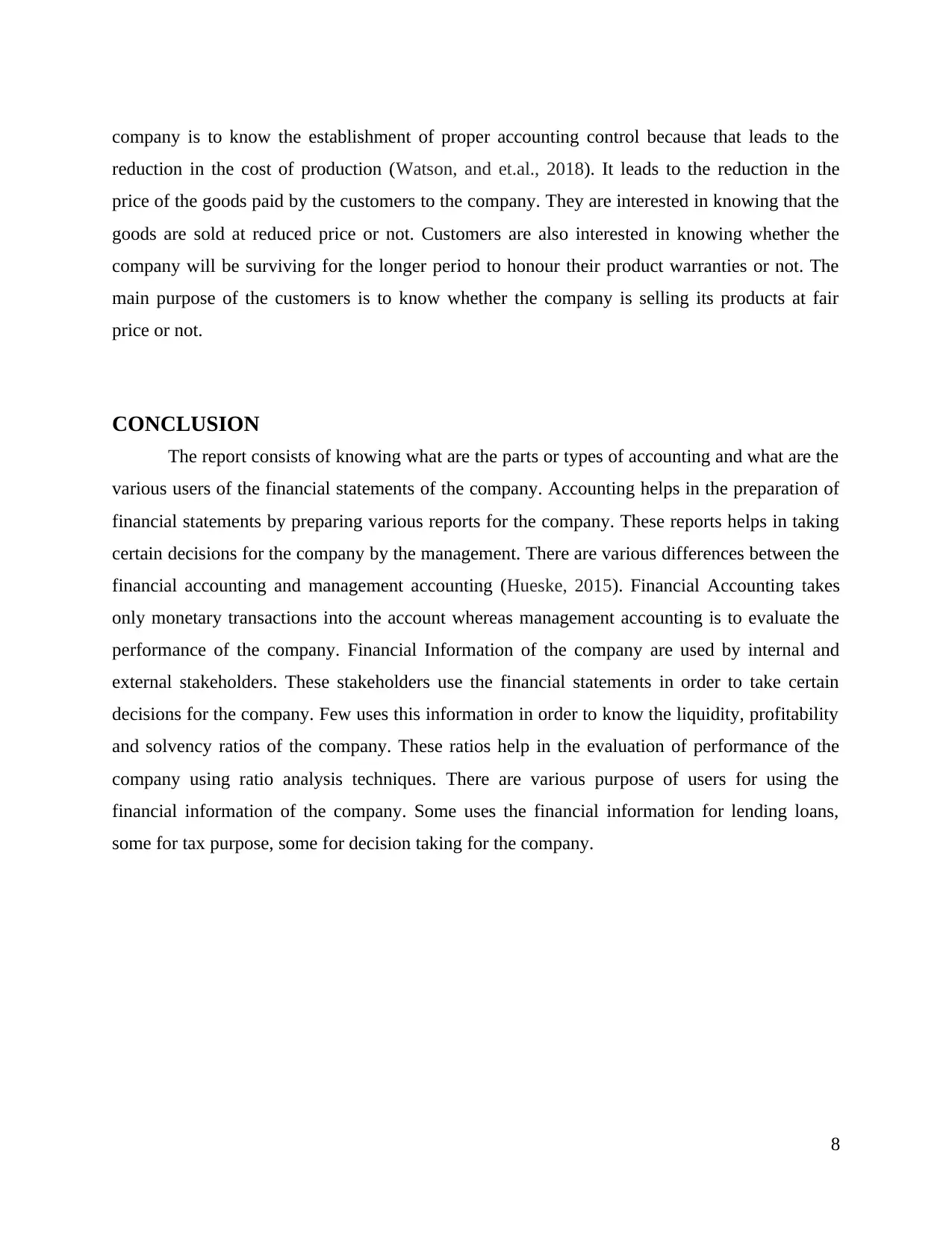
company is to know the establishment of proper accounting control because that leads to the
reduction in the cost of production (Watson, and et.al., 2018). It leads to the reduction in the
price of the goods paid by the customers to the company. They are interested in knowing that the
goods are sold at reduced price or not. Customers are also interested in knowing whether the
company will be surviving for the longer period to honour their product warranties or not. The
main purpose of the customers is to know whether the company is selling its products at fair
price or not.
CONCLUSION
The report consists of knowing what are the parts or types of accounting and what are the
various users of the financial statements of the company. Accounting helps in the preparation of
financial statements by preparing various reports for the company. These reports helps in taking
certain decisions for the company by the management. There are various differences between the
financial accounting and management accounting (Hueske, 2015). Financial Accounting takes
only monetary transactions into the account whereas management accounting is to evaluate the
performance of the company. Financial Information of the company are used by internal and
external stakeholders. These stakeholders use the financial statements in order to take certain
decisions for the company. Few uses this information in order to know the liquidity, profitability
and solvency ratios of the company. These ratios help in the evaluation of performance of the
company using ratio analysis techniques. There are various purpose of users for using the
financial information of the company. Some uses the financial information for lending loans,
some for tax purpose, some for decision taking for the company.
8
reduction in the cost of production (Watson, and et.al., 2018). It leads to the reduction in the
price of the goods paid by the customers to the company. They are interested in knowing that the
goods are sold at reduced price or not. Customers are also interested in knowing whether the
company will be surviving for the longer period to honour their product warranties or not. The
main purpose of the customers is to know whether the company is selling its products at fair
price or not.
CONCLUSION
The report consists of knowing what are the parts or types of accounting and what are the
various users of the financial statements of the company. Accounting helps in the preparation of
financial statements by preparing various reports for the company. These reports helps in taking
certain decisions for the company by the management. There are various differences between the
financial accounting and management accounting (Hueske, 2015). Financial Accounting takes
only monetary transactions into the account whereas management accounting is to evaluate the
performance of the company. Financial Information of the company are used by internal and
external stakeholders. These stakeholders use the financial statements in order to take certain
decisions for the company. Few uses this information in order to know the liquidity, profitability
and solvency ratios of the company. These ratios help in the evaluation of performance of the
company using ratio analysis techniques. There are various purpose of users for using the
financial information of the company. Some uses the financial information for lending loans,
some for tax purpose, some for decision taking for the company.
8
Paraphrase This Document
Need a fresh take? Get an instant paraphrase of this document with our AI Paraphraser
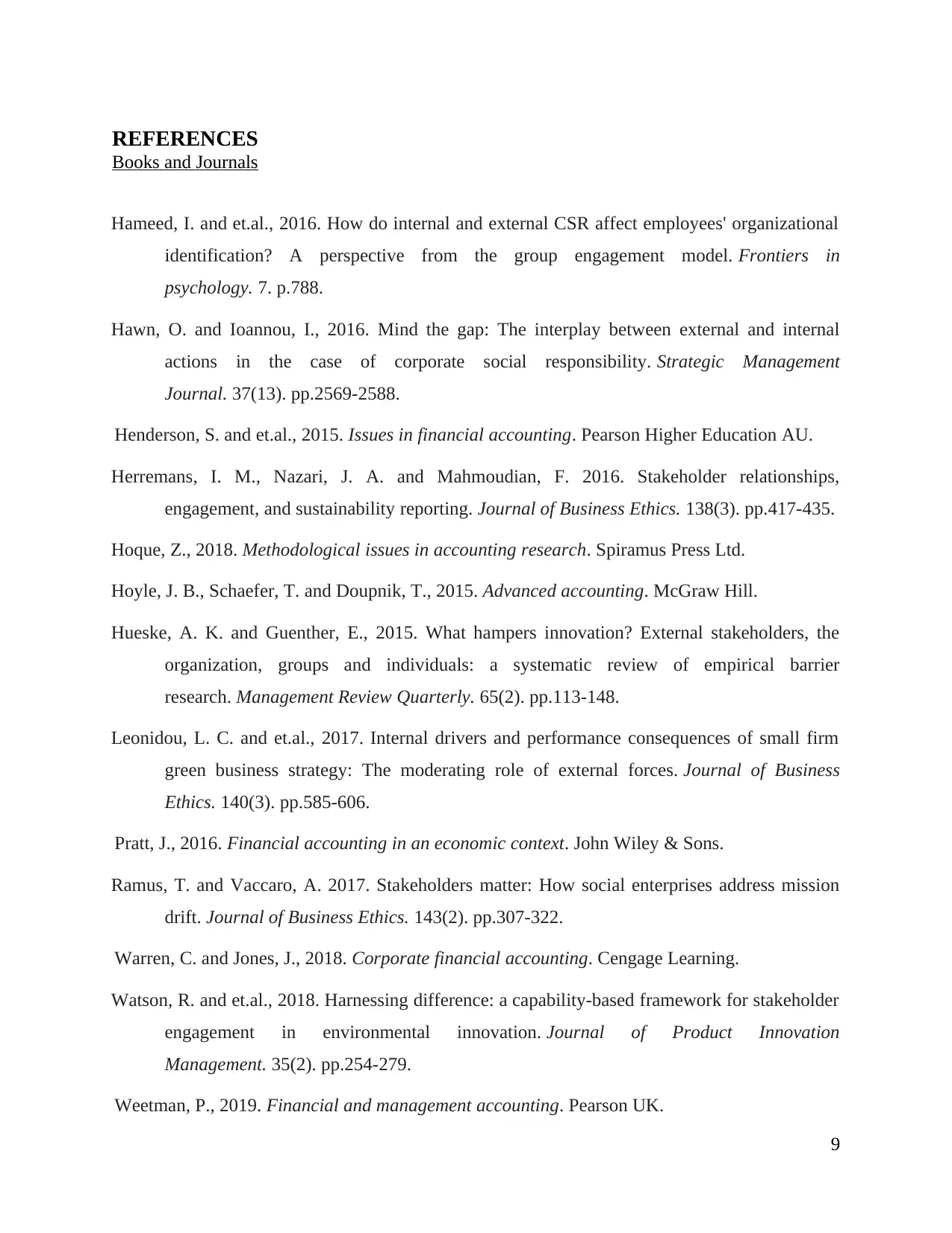
REFERENCES
Books and Journals
Hameed, I. and et.al., 2016. How do internal and external CSR affect employees' organizational
identification? A perspective from the group engagement model. Frontiers in
psychology. 7. p.788.
Hawn, O. and Ioannou, I., 2016. Mind the gap: The interplay between external and internal
actions in the case of corporate social responsibility. Strategic Management
Journal. 37(13). pp.2569-2588.
Henderson, S. and et.al., 2015. Issues in financial accounting. Pearson Higher Education AU.
Herremans, I. M., Nazari, J. A. and Mahmoudian, F. 2016. Stakeholder relationships,
engagement, and sustainability reporting. Journal of Business Ethics. 138(3). pp.417-435.
Hoque, Z., 2018. Methodological issues in accounting research. Spiramus Press Ltd.
Hoyle, J. B., Schaefer, T. and Doupnik, T., 2015. Advanced accounting. McGraw Hill.
Hueske, A. K. and Guenther, E., 2015. What hampers innovation? External stakeholders, the
organization, groups and individuals: a systematic review of empirical barrier
research. Management Review Quarterly. 65(2). pp.113-148.
Leonidou, L. C. and et.al., 2017. Internal drivers and performance consequences of small firm
green business strategy: The moderating role of external forces. Journal of Business
Ethics. 140(3). pp.585-606.
Pratt, J., 2016. Financial accounting in an economic context. John Wiley & Sons.
Ramus, T. and Vaccaro, A. 2017. Stakeholders matter: How social enterprises address mission
drift. Journal of Business Ethics. 143(2). pp.307-322.
Warren, C. and Jones, J., 2018. Corporate financial accounting. Cengage Learning.
Watson, R. and et.al., 2018. Harnessing difference: a capability‐based framework for stakeholder
engagement in environmental innovation. Journal of Product Innovation
Management. 35(2). pp.254-279.
Weetman, P., 2019. Financial and management accounting. Pearson UK.
9
Books and Journals
Hameed, I. and et.al., 2016. How do internal and external CSR affect employees' organizational
identification? A perspective from the group engagement model. Frontiers in
psychology. 7. p.788.
Hawn, O. and Ioannou, I., 2016. Mind the gap: The interplay between external and internal
actions in the case of corporate social responsibility. Strategic Management
Journal. 37(13). pp.2569-2588.
Henderson, S. and et.al., 2015. Issues in financial accounting. Pearson Higher Education AU.
Herremans, I. M., Nazari, J. A. and Mahmoudian, F. 2016. Stakeholder relationships,
engagement, and sustainability reporting. Journal of Business Ethics. 138(3). pp.417-435.
Hoque, Z., 2018. Methodological issues in accounting research. Spiramus Press Ltd.
Hoyle, J. B., Schaefer, T. and Doupnik, T., 2015. Advanced accounting. McGraw Hill.
Hueske, A. K. and Guenther, E., 2015. What hampers innovation? External stakeholders, the
organization, groups and individuals: a systematic review of empirical barrier
research. Management Review Quarterly. 65(2). pp.113-148.
Leonidou, L. C. and et.al., 2017. Internal drivers and performance consequences of small firm
green business strategy: The moderating role of external forces. Journal of Business
Ethics. 140(3). pp.585-606.
Pratt, J., 2016. Financial accounting in an economic context. John Wiley & Sons.
Ramus, T. and Vaccaro, A. 2017. Stakeholders matter: How social enterprises address mission
drift. Journal of Business Ethics. 143(2). pp.307-322.
Warren, C. and Jones, J., 2018. Corporate financial accounting. Cengage Learning.
Watson, R. and et.al., 2018. Harnessing difference: a capability‐based framework for stakeholder
engagement in environmental innovation. Journal of Product Innovation
Management. 35(2). pp.254-279.
Weetman, P., 2019. Financial and management accounting. Pearson UK.
9

Online
Accounting. 2019. (Online). Available through <https://www.accountingcoach.com/accounting-
basics/explanation>
10
Accounting. 2019. (Online). Available through <https://www.accountingcoach.com/accounting-
basics/explanation>
10
⊘ This is a preview!⊘
Do you want full access?
Subscribe today to unlock all pages.

Trusted by 1+ million students worldwide
1 out of 12
Related Documents
Your All-in-One AI-Powered Toolkit for Academic Success.
+13062052269
info@desklib.com
Available 24*7 on WhatsApp / Email
![[object Object]](/_next/static/media/star-bottom.7253800d.svg)
Unlock your academic potential
Copyright © 2020–2025 A2Z Services. All Rights Reserved. Developed and managed by ZUCOL.




